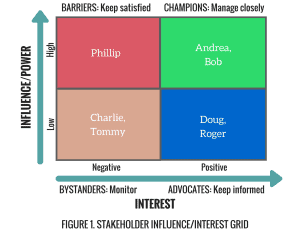Eight Powerful Project Management Processes Part 6: Communication Plan
/*Eight Powerful Project Management Processes Part 6: Communication Plan

In Part Six of our “Eight Powerful Project Management Processes” series, we examine the communication plan. These processes are also included in our toolkit, Essential Gear for Project Managers.
Project managers bring many important skills to the table. Many project managers might think their ability to plan is the most critical skill they offer, but in our opinion, their ability to communicate effectively is of much greater importance. Communication can make or break a project. It is critical for project managers to establish appropriate communication channels, as well as build and support project organizational structures that facilitate open communication, foster creativity, promote team spirit, and aid in winning the support of key stakeholders. The starting point for establishing these channels and building these structures is the communication plan.
When building the communication plan, there are many best practices and pitfalls to keep in mind. Following the best practices and avoiding the pitfalls should help in crafting a comprehensive and effective communication plan. Some best practices and associated pitfalls:
1. Do stakeholder analysis before starting the communication plan
Some of these processes can be done at different times throughout the project, and many will be done more than once, but identifying all stakeholders helps ensure that the communication plan is also complete.
Doing stakeholder analysis also helps the project manager identify the four types of stakeholders: champions, advocates, bystanders, and barriers. If you recall from stakeholder analysis, these four types are defined by their ability to impactthe project and their level of interest in the project. Table 1 below shows the four types mapped by squares.
The communication plan is an important piece of the project manager’s strategy to both move stakeholder engagement from current to desired levels and maintain desired levels of stakeholder engagement. In particular, project managers should keep their project’s champions well-informed. Champions are often able to offer key support when a project hits trouble spots.
Leaving off stakeholders is a pitfall. If stakeholders are left off, then they will not be included in the communication plan, and the project’s communications will not be complete. Failing to include all stakeholders can result in two consequences. One, the engagement levels of stakeholders not included can fall from positive to negative, resulting in barriers to the project. Two, stakeholders who are not included cannot offer their support to the project, meaning that key allies have not been taken into account. To avoid these consequences, conduct comprehensive stakeholder identification and analysis before developing the communication plan.
2. Use the communication channel formula to analyze all communication channels.
If you are not familiar with the communication channel formula, it is (n*(n-1))/2 where n is the number of people involved in the project.
This formula is significant because it helps the project manager set realistic expectations and plan accordingly. The more people are on the project, the more complex the communication becomes.
When calculating the communication channels, project managers may often forget to include one key person—themselves! This is a pitfall because the project manager is also engaging in project communications, and he or she needs to be included in the analysis to ensure it is complete. When establishing communication roles and responsibilities in the plan, the project manager also needs to include his or her role, or roles, in communication to establish further accountability for communication success.
3. Keep organizational structure and culture in mind.
Organizational structure is important for project managers to keep in mind because it establishes reporting relationships among team members and managers as well as whether communication is horizontal or vertical. Organizational culture is an important factor in establishing project communication because it shows what norms and expectations are already in place. For example, if a project’s developers typically spend one hour after lunch away from email in order to work on their projects, it is not a good idea to try and send them an email one hour after lunch.
It is also important to look at the organizational structure and culture of other organizations involved in the project, especially vendors. When engaging in virtual communication, respecting time zone differences as well as cultural values and norms goes a long way in sustaining effective communication, which is even more important when teams do not usually meet face-to-face.
4. Facilitate open, honest, and timely communication.
In other words, once the communication plan is in place, use it. It is important to ensure that everyone adheres to the communication plan once they have agreed to it so that the project stays on track, everyone receives the information they need, and the climate around the project remains a positive one based on trust.
Failing to adhere to the communication plan as it was agreed to is a major pitfall. Stakeholders who are left out of communications will sour on the project and their engagement levels might drop. Communication that is dishonest is an ethical breach and should not be allowed to happen. Finally, communication that is not timely fails to keep information flowing at the rate it needs to in order to facilitate project success.
5. Identify all sources of “noise.”
Noise includes any interference or barriers that might compromise the transmission of a message. Some possible sources of noise include:
- Distance
- Unfamiliarity with the technology
- Inadequate Infrastructure
- Cultural Differences
- Lack of Background Information or Context
The more noise that exists in project communication, the more risk there is to the project. Team members may not always relay that something is wrong; they may just try a different mode of communication or give up on trying to communicate. Both of these are red flags. Second, noise represents an opportunity to collect feedback on the communication plan. For example, if noise comes up as a result of team members being unfamiliar with new communication technology during a meeting, that is a signal that they need more training to use it properly or that different communication technology might be needed.
Like stakeholder analysis, failure to perform noise analysis is a pitfall that can have two consequences. First, this failure means the project manager is ignorant of potential risks resulting from miscommunications. Second, this failure means the project manager is missing out on valuable opportunities to improve the communication plan and make it work better for the team and stakeholders.
6. Solicit regular feedback on how communications and the plan can be improved.
The presence of noise in communication is one indicator that project communications need improvement. Project managers also need to make sure that team members and stakeholders feel free to suggest improvements themselves. It may come through emails or through an open forum, but project managers need to be open to feedback on the communication and work on implementing relevant feedback.
Treating the communication plan as a one-time document is a pitfall. Just as communications will evolve over the course of a project, the communication plan should also evolve. Not only will communication needs change, but it is likely also that new team members and stakeholders will enter the project, and their needs must be considered as well.
Following these steps, and avoiding their related pitfalls, can help project managers build a solid and sustainable communication plan to increase the chances of project success and minimize unnecessary risks based on miscommunication or failure to communicate.
What are your experiences with project communication? Please let us know in the comments.
Essential Gear for Project Managers is a toolkit with the eight essential project management processes you need to deliver projects on time, on budget, and exceeding expectations. Delivered to you via intuitive templates and a handbook describing best practices and pitfalls.
